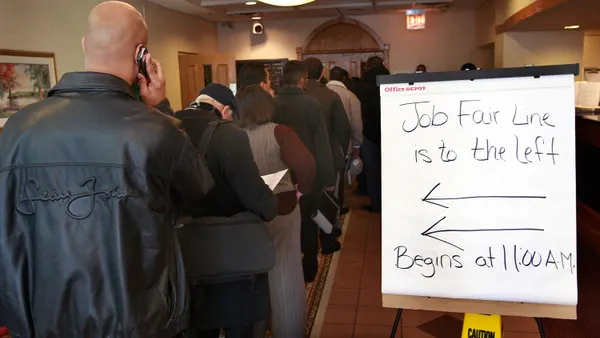Dive Brief:
- A lack of access to jobs at the top of the company continues to drive the gender pay gap, according to research from PayScale. The new study, The State of the Gender Pay Gap in 2019, offers insight into where the system breaks down for women and people of color — and data suggests that an "opportunity gap" may be the primary reason wage parity does not yet exist.
- Women face more barriers in the workplace that keep them in lower paid, lower level “individual contributor positions” as opposed to their male counterparts at the executive and management levels, the research noted. When women of color are factored into the equation, additional biases and barriers block their ability to reach parity.
- Although modestly improved by 1% over the previous year, women still earn only 79 cents for every dollar earned by men. This data measures median salary without regard to job type, location, seniority, years of experience or industry. The controlled pay gap is only 98 cents to every dollar — but that stat does not paint the whole picture, PayScale said, as women of color consistently earn less than white men.
Dive Insight:
Most experts agree that wage disparity is not improving for women — and, according to the Economic Policy Institute, it may only get worse going into 2019. Women may be paid up to 45% less than men for the same job in certain fields, a Hired report showed, and women's actual earnings may only be 49% of men's earnings once measured by total earnings "across the most recent 15 years for all workers who worked in at least one year," a Georgetown study noted. At the current rate, pay equity won't be reached for another 108 years, the World Economic Forum revealed in its gender gap index at the end of 2018.
Some solutions have seen some success. Government-mandated disclosures have been shown to narrow the gender wage gap, according to research published in February; Danish legislation that required companies with more than 35 employees to report on gender pay gaps brought about pay gap shrinkage for those companies, the research revealed. Activist investors have also turned sharp eyes on the gender pay gap, prompting big name companies to disclose their pay gaps (and thus encourage work to fix them).
In turn, companies are jumping on the equity bandwagon, publishing their unadjusted pay gaps and generally going more public with the issue. In Silicon Valley, some leaders have made parity a priority, and discussed the issue last year on Equal Pay Day. To manage their brand and assure fairness in the workplace, businesses will need to keep focus on this issue, not just as an annual discussion, but as a driver for change and equality across gender and racial lines.













